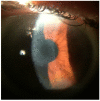Complications of Small Aperture Intracorneal Inlays: A Literature Review
- PMID: 36836669
- PMCID: PMC9965951
- DOI: 10.3390/life13020312
Complications of Small Aperture Intracorneal Inlays: A Literature Review
Abstract
Presbyopia can be defined as the refractive state of the eye in which, due to a physiological decrease in the ability to accommodate, it is not possible to sustain vision without fatigue in a prolonged manner, along with difficulty focusing near vision. It is estimated that its prevalence in 2030 will be approximately 2.1 billion people. Corneal inlays are an alternative in the correction of presbyopia. They are implanted beneath a laser-assisted in situ keratomileusis (LASIK) flap or in a pocket in the center of the cornea of the non-dominant eye. The purpose of this review is to provide information about intraoperative and postoperative KAMRA inlay complications in the available scientific literature. A search was conducted on PubMed, Web of Science, and Scopus with the following search strategy: ("KAMRA inlay" OR "KAMRA" OR "corneal inlay pinhole" OR "pinhole effect intracorneal" OR "SAICI" OR "small aperture intracorneal inlay") AND ("complication" OR "explantation" OR "explanted" OR "retired"). The bibliography consulted shows that the insertion of a KAMRA inlay is an effective procedure that improves near vision with a slight decrease in distance vision. However, postoperative complications such as corneal fibrosis, epithelial iron deposits, and stromal haze are described.
Keywords: KAMRA inlay; SAICI; corneal inlay pinhole; intraoperative complications; postoperative complications; presbyopia; refractive surgery; small aperture intracorneal inlay.
Conflict of interest statement
The authors declare no conflict of interest.
Figures




Similar articles
-
Effects of femtosecond and excimer lasers on implanted KAMRA corneal inlay in animal models.J Fr Ophtalmol. 2017 May;40(5):403-407. doi: 10.1016/j.jfo.2016.11.011. Epub 2017 Mar 27. J Fr Ophtalmol. 2017. PMID: 28359626
-
Long-term Results of Combined LASIK and Monocular Small-Aperture Corneal Inlay Implantation.J Refract Surg. 2016 Jun 1;32(6):379-84. doi: 10.3928/1081597X-20160317-01. J Refract Surg. 2016. PMID: 27304601
-
AcuFocus Corneal Inlay to Correct Presbyopia Using Femto-LASIK. One Year Results of a Prospective Cohort Study.Klin Monbl Augenheilkd. 2016 Apr;233(4):360-4. doi: 10.1055/s-0041-111804. Epub 2016 Apr 26. Klin Monbl Augenheilkd. 2016. PMID: 27116483 Clinical Trial. English.
-
Intracorneal Inlays for the Correction of Presbyopia.Eye Contact Lens. 2017 Sep;43(5):267-275. doi: 10.1097/ICL.0000000000000381. Eye Contact Lens. 2017. PMID: 28617724 Review.
-
Inlays and the cornea.Exp Eye Res. 2021 Apr;205:108474. doi: 10.1016/j.exer.2021.108474. Epub 2021 Jan 29. Exp Eye Res. 2021. PMID: 33524364 Review.
Cited by
-
Theranostic-Guided UV-A Light Corneal Wavefront Photo-Reshaping for Presbyopia Correction: A Preclinical Study.J Biophotonics. 2025 Feb;18(2):e202400462. doi: 10.1002/jbio.202400462. Epub 2024 Dec 12. J Biophotonics. 2025. PMID: 39667724 Free PMC article.
References
-
- Ayoub S.C., Ahmad M. Presbyopia: Clinical Update. Insight. 2017;42:29–36. - PubMed
Publication types
LinkOut - more resources
Full Text Sources

